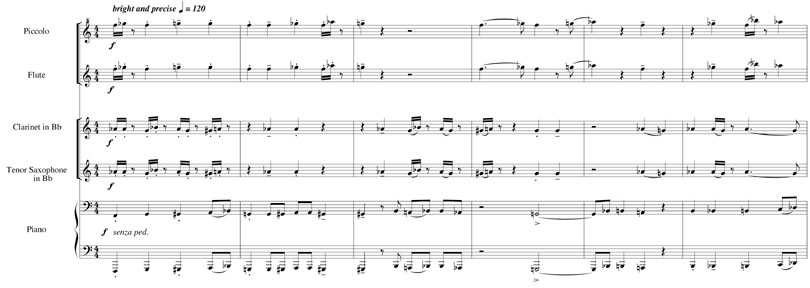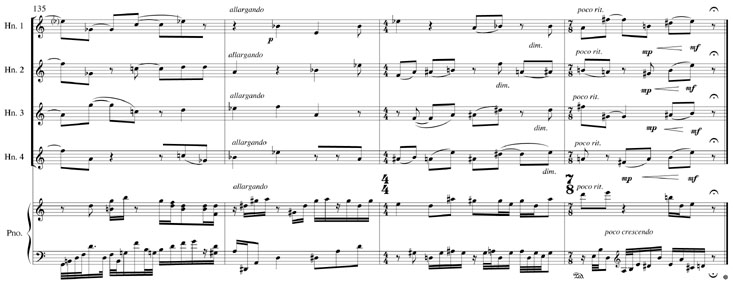A seven movement work for wind, brass, percussion and piano. Written in 1992, revised 2007.

![]()
![]() from Heartstone I: Chert
from Heartstone I: Chert
![]()
![]()
Heartstone completes a series of compositions written between 1986 and 1992 that mark out a pathway towards the exploration of two musical issues. The first concerns a composer’s relationship between the musical event and the instrumental sound. The second investigates the ways and means of human computer interaction with the traditional techniques of music composition. Both issues come together in these compositions: from the radical Metanoia for variable ensemble written in the AMPLE music language, through the sequence of four chamber works written under the title TOUCHED BY MACHINE? which explore the tools of the MIDI studio, to Heartstone itself – the composer’s first major work using an expert system.
This score for 16 players belongs to a vigorous repertoire for mixed ensemble made up of works by composers such as Louis Andriessen, Steve Martland, Graham Fitkin and Michael Torke. Here performance techniques and articulations from rock and jazz combine with the kind of ensemble synchronicity and purpose achieved by, amongst others, Steve Reich and his Musicians. Many of these scores also seek a democracy of role, interest and activity between parts and players often encouraging freedom in dynamics, articulation and choice of timbre.

![]()
![]() from Heartstone II: Prase
from Heartstone II: Prase
![]()
Heartstone was completed in 1992 and extensively revised in 2007. The score was composed with a Lisp-based expert-system. This system enabled relationships between musical parameters, difficult if not impossible to make with conventional means, to be explored and new material generated. For example, in the score of Heartstone the concept of extended tonality is a recurring feature in the compositional argument.
The notion of traditional associations between stone, earth and direction found in Chinese music formed the backdrop for imaginary journeys with new tonality schemes derived from melodic, rhythmic, and dynamic material. Algorithmically-structured tonality counterpoint was achieved between different instrumental parts (see Movement 3) and tonalities were made to modulate with one another, just as a sine wave might modulate another wave form on an analogue synthesiser.

![]() from Heartstone VI: Paramoudra
from Heartstone VI: Paramoudra
![]()
Heartstone documents the potential of purely symbolic composition and the composer’s developing relationship with a new language for imagining and designing music. The seven movement score uses a wide variety of generative devices, in particular fractal algorithms, associative structures, L-systems and the Fibonacci series. The music is recursive; it seeks to come to an understanding about its nature, content and context by creating descriptions of itself, in terms of itself. There is a high level of self-similarity present throughout; the pitch design of one short phrase may also provide a template for the structure of a whole movement.
Heartstone was written for the conductor and oboist Timothy Redmond and the RNCM wind orchestra. Its first performance was given in 1995 in a version for symphonic band (now withdrawn) by the Wind Orchestra of University College Bretton Hall (now Leeds University) with Barry Russell as the solo pianist.
Access a dynamic web presentation and downloadable material here.
